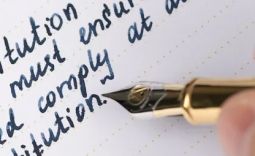Frozen words
How did the history of mankind begin? Obviously it was since the moment when some genius mind came up with the idea to invent writing system. People can only guess or hypothesize and theorize, at best, with the help of artefacts from digs, about everything that happened before this truly revolutionary hour.
It was exactly writing that gave us documents - veritable evidence of all actions performed by homo sapiens thousands of years ago in different corners of the earth.
Fortunately, thoughts, messages and reports have come down to us, fixed on a stone or on a clay tablet, on a piece of buffalo skin, on a birch bark or a sheet of papyrus, so we now have the opportunity to estimate our ancestors way of living, their interests and problems.
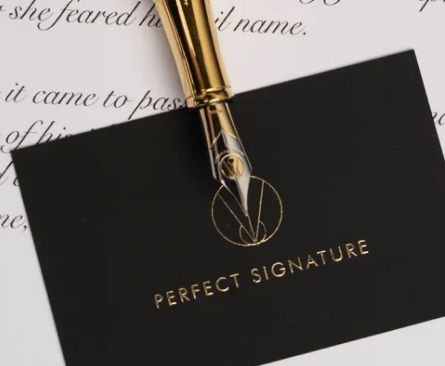
The invention of writing opened up a hitherto-unprecedented opportunity of distant communication to the people - now not in short, from lip to lip, but over long distances, for dozens of days on foot, by water or caravan track. As a result, small human communities began to destroy the framework of isolated compact clans and tribes and unite into nationalities and peoples, primarily on the language and dialects kinship basis.
Messages, based on images of objects, numbers or actions are historically the first documents, not made of pebbles or shells, but of handwritten symbols. A kind of international writing, easily understandable by people speaking different languages. The word «man» was associated with a pictogram of a primitive drawing of a man, the word «dwelling» was conveyed by a drawing of a hut, and, for example, the verb «to go» - by an image of, say, legs.
It is clear, that such kind of lettering was capable of conveying the simplest thoughts and actions only, therefore, the pictograms in some regions were later replaced by hieroglyphs, in others by a set of symbols reflecting syllabes, and finally in third ones by by alphabets where letters correlated with sounds.
Appropriate tools were, of course, needed for writing, so they appeared about six thousand years ago in the Mesopotamia region, where local literate people scratched clay plates with pointed rods made of bone or bronze.
About ten centuries later, the ancient Egyptians came up with the idea of applying dye to parchment or papyrus using a thin reed brush. 3300 years ago, the Romans made notes with a stylus on tablets covered with a thin layer of wax. This method made it possible to erase what was written with the blunt end of the stylus.

The first tool that we can safely call today «the eternal fountain pen» was proposed in the early 1880s by Lewis Edson Waterman, an insurance salesman in New York City, who quickly turned into a stationary salesman. He was the inventor of the feeder - a capillary mechanism that fed ink from a reservoir to the nib, and so that the pen did neither flow nor leave blots.
The principle of action of the fountain pen has, henceforward, remained unaltered, with only changes in the materials of the pen body and nibs, in the reservoirs options and in the general design.
Over these 140 years talented tinkerers, certified engineers and designers have invented and launched into production ball refills and felt-tip pens, rollerball pens and gel-glide pens, but classic fountain pens are not going to go the way of the dodo, because writing with a first-class «eternal pen» is incomparable pleasure.
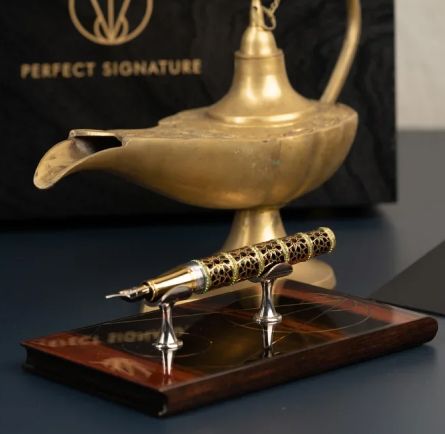
On the cusp of the 18th and 19th centuries, small European manufactories offered amateurs of the epistolary genre to switch from goose to steel quills, which did not get soaked, so their tips did not have to be regularly cut off and prepared for service. One more problem remained to be resolved: to attach a small container to the quill to save people from the annoying activity of constantly dipping the nib to the inkpot.
A student in Paris, Petrache Poenaru, has solved this problem. His invention bore the pretentious name «Never-ending portable pen, which recharges itself with ink».
Since then, there have been many discoveries that made it possible to significantly modernize Poenaru’s fountain pen, and later this writing instrument passed into the category of objects that cannot be dispensed with.
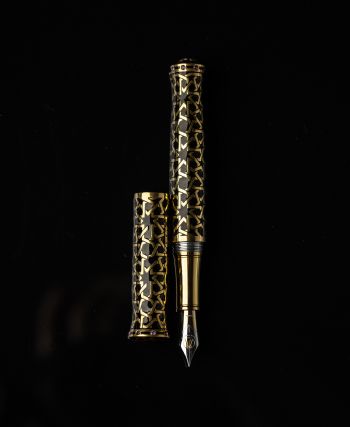
Fountain pens differ not only in the type of nibs, but also in the filling system.
- The cartridge/converter filling system. The cartridge/converter system provides a unified seat at the top of the feeder, where either an ink cartridge or a piston converter (cylindrical reservoir with a syringe-like piston) can be installed.
- Pens with built-in slide-piston type converter. To fill the pen the nib is dipped into ink, which is drawn into the reservoir by moving the slider in the same way as in a syringe.
- Pens with built-in screw-piston type converter. Here the screw-mounted piston is moved upward by rotating an elongated cylindrical plastic nut with a notch, to avoid fingers slipping.
- Pens with pipette or aerometric filling system. The ink reservoir in this case is a rubber pipette with a thin tube passing through. By pressing the pipette air is squeezed out through the pen point and by releasing ink is sucked in through the tube.
- Snorkel pens. Special tube is pulled out to fill the pen reservoir, so it is no longer necessary to dip the pen point into the ink.
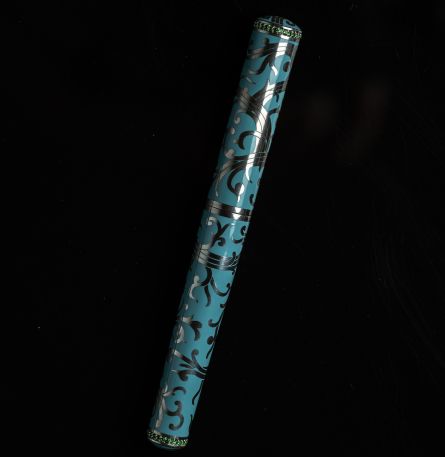
Diamonds between fingers
Nowadays, at the turn of the first half of the 21th century, a stunning tendency is firmly established in the social consciousness - a return to old utilitarian tools and mechanisms as attributes of luxury. Vinyl turntables, wrist watches with no signs of electronics, fountain pens - all these trivial things, quite ordinary in the recent past and almost forgotten for decades, turned as if by magic into symbols of high status, stylish exclusive items, collectible objects.
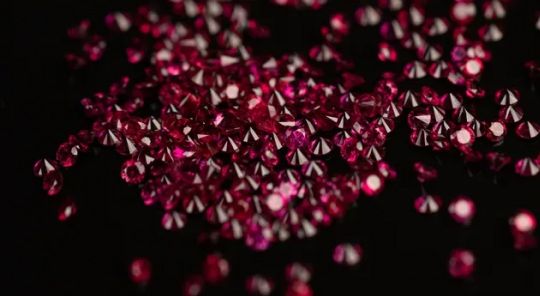
Some social scientists and researchers believe that almost imperceptible, gradual increase of irritation, caused by an endless stream of inventions and implementations of tens and hundreds of technical innovations was the key player here. As a result many of us experience digital fatigue and the perception of new technologies is getting harder and slower every year.
Or perhaps the fact is that people, however, with some delay, finally realized that vinyl, mechanical watches and ink fountain pens are, despite the obvious discrepancy between spheres of application, some kind of technical culture monuments. It was they, each individually and each in its own time, who were at the peak of the creative search for engineers, designers and technologists.
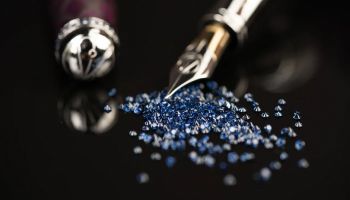
Perhaps the most vivid example of a return to the highlights of the past, or, on the contrary, of a forward movement towards tomorrow’s ideals, are fountain pens, objects that often seem almost animated to us. Indeed, there is something deeply personal, intimate in handwriting.
This is a very special process that requires control, leisureliness and ability to get a grip. It is not surprising, therefore, that it was with those who enjoy the pen sliding on paper that the trend on fountain pens as elements of style began and grew at its apogee into fashion for such models that are not only inimitable writing instruments, but also genuine masterpieces of jewellery art.
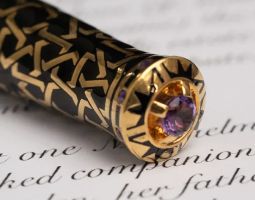
The limited editions fountain pens have become in addition to their original function, a reflection of the high status, success and prosperity of their owners.
Despite the high cost or maybe because of it, the popularity of luxury pens is growing every year. The selection of high-end fountain pens on the world market impresses with a variety of technical solutions and artistic images. The body of such an instrument can be made of rare wood, precious metal or gemstone, and the delicate ornament can be enriched with patterned enamel, rubies, sapphires, emeralds and diamonds.
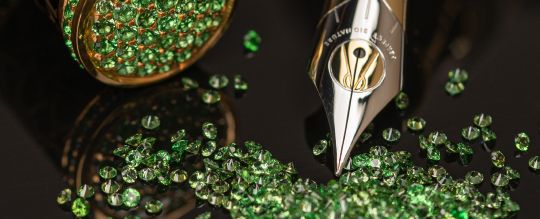
Eternal quills of eternal persons
Today probably not a single historian, even the most reputed one, will tell you with which quill Giovanni Boccaccio wrote his Decameron, with what Cardinal Richelieu approved the most important documents, or what brand of writing instrument Wolfgang Amadeus Mozart used to edit the score of The Marriage of Figaro. The quill of the genius, an extension of his hand, remained unknown, it was a penniless disposable сonsumable, a by-product of agriculture.
The situation improved somewhat when steel quills came into use. It was already a real branch of industry, and, in addition to price, categories such as quality, durability, brand and model with certain properties have become applicable to quills as to any other industrial product entering the market.
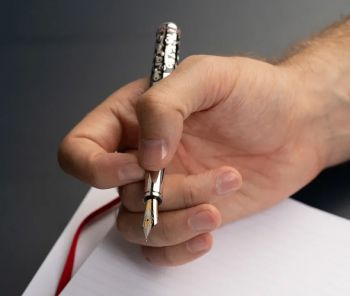
Everything changed radically after the appearance of another miracle of the scientific and technological revolution of the 19th century - the «eternal quill». From that moment on, writing instruments became, if not eternal, then durable. Literally out of the blue, manufacturing companies arose, new brands were born and needed advertising, and advertising, in its turn, needed celebrities.
That is why today we know for sure which fountain pen Sir Arthur Conan Doyle used to trace out words «The Memoirs of Sherlock Holmes» on the manuscript, and what Mark Twain said about his eternal quill, which, thanks to a unique filling mechanism, did not roll off the table.
Winston Churchill, as a true patriot, preferred the classic high-quality English-made pens with lever-action filling system, and Walt Disney loved writing instruments with a unique design and inimitable style.
Ernest Hemingway also took part in the advertising of fountain pens, or rather not the writer himself, but only his right hand. To be fair we need to say, that in fact the great American wrote his works not with ink, but with a pencil.
In 1945, Eisenhower signed the German Instrument of Surrender with a fountain pen, which model became famous all over the world. By the way with exactly the same pen General McArthur signed the Japanese Instrument of Surrender.
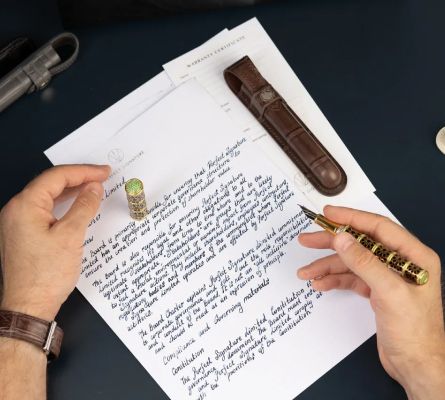
For some time now, a special category of fountain pens has been produced in the United States - ones for the presidents of the country to sign official documents. There are two versions of the origins of these essential instruments: some researchers say these pens were first custom made for the Eisenhower administration in the 50s of the last century, their opponents believe that the first president who demanded special purpose models for his administration was Harry S. Truman.
The unique fountain pens were made specially for the Intermediate-Range Nuclear Forces Treaty procedure and were used by Ronald Reagan and Mikhail Gorbachev to sign the document.
